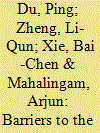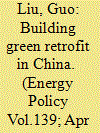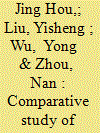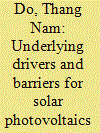|
|
|
Sort Order |
|
|
|
Items / Page
|
|
|
|
|
|
|
| Srl | Item |
| 1 |
ID:
136231


|
|
|
|
|
| Summary/Abstract |
The building sector of China currently consumes 20% of the total energy consumption. Studies on barriers to the adoption of building energy-saving technologies are of great significance on implementing policies related to achieving energy-saving goals. This paper studied 15 barriers with the aid of information collected through questionnaires and semi-structured interviews. The respondents were 135 employees working in the Jing-jin-tang area. Based on the results of the factor analysis, the barriers were categorized into five groups: attitudes of stakeholders, policies and regulations, auxiliary resources, profitability, and adaptability of the technologies. Analysis of the entire sample showed that the stakeholders’ reluctance to use was the largest barrier, followed by high initial investment and low profitability. Further analysis showed that the occupation and designation of the respondents and the size of the enterprises that they served influenced their perspectives on the barriers. It was found that architects attributed more importance to the adoption of energy-saving technologies than contractors; barriers confronted by employees of large enterprises and small enterprises were different; managers perceived weaker barriers than frontline employees and were more optimistic about the prospect of building energy-saving technologies. Finally, policy recommendations were proposed based on these in-depth and targeted analyses.
|
|
|
|
|
|
|
|
|
|
|
|
|
|
|
|
| 2 |
ID:
176702


|
|
|
|
|
| Summary/Abstract |
Green retrofit is an effective way of improving the performance of existing buildings to achieve low energy consumption and low carbon emission. To realize a successful building green retrofit, it is important to understand the barriers and to develop relevant policies for retrofitting existing buildings, especially in developing countries. As a typical developing country, China has a large number of aged buildings with high green retrofit potential. In terms of its government structure, economic development, and building stocks, China is unique in that it poses a unique set of barriers and policy strategies on the promotion of building green retrofit. Based on a critical review, existing retrofit policies in China were reviewed. Then, the barriers to building green retrofit within the context of China were identified. Based on the study of existing policies and barriers, relevant policies for addressing these barriers are recommended. The findings provide a valuable reference for policy makers in China to review current building green retrofit policies or to develop new policies that address the barriers. This study also provides a useful reference for other countries aiming to review their building green retrofit policies.
|
|
|
|
|
|
|
|
|
|
|
|
|
|
|
|
| 3 |
ID:
150362


|
|
|
|
|
| Summary/Abstract |
The energy efficiency of existing commercial buildings is more challenging to regulate and improve than the energy efficiency of new constructions. In 2011 and 2012, the Chinese Government selected four cities- Shanghai, Tianjin, Shenzhen, and Chongqing- to implement pilot commercial building energy efficiency retrofit program. Based on site surveys and expert interviews in these pilot cities, this research conducted a comparative analysis on incentive policies of local city level. The analysis results show that policy designs of existing commercial buildings should be further improved. The aspects that influence the implementation effect in the future, such as subsidy level, installments, and business model promotion, should be specified in the policy clauses. Referring to the technical solution and cost-benefit in Chongqing, we found that lighting system is the most common retrofit objects while envelope system is the least common one. And the subsidy incentive is greatest for educational buildings, followed by office buildings. In the end, we further discussed the problems and obstacles in commercial building retrofit market, and provided a series of recommendations.
|
|
|
|
|
|
|
|
|
|
|
|
|
|
|
|
| 4 |
ID:
176873


|
|
|
|
|
| Summary/Abstract |
Vietnam experienced a solar photovoltaic (PV) installation boom in the first half of 2019, with installed capacity increasing to 4,450 MW. This saw Vietnam overtake Thailand to have the largest installed solar PV capacity in Southeast Asia. This paper investigates the underlying drivers of Vietnam's solar boom, barriers to further solar adoption, and suitable strategies for the next stage of solar adoption. Forty-six semi-structured interviews were conducted with experts from government agencies, international organizations, non-governmental organizations, universities, research institutions, and industry. A generous feed-in tariff (FIT) of US$93.5/MWh for new projects, together with supporting policies such as tax exemptions, are found to be the key proximate drivers of Vietnam's solar PV boom. Underlying drivers include the government's desire to enhance energy self-sufficiency and the public's demand for local environmental quality. Limited transmission grid capacity and complex administrative procedures are among the key barriers. Looking forward, Vietnam has substantial potential to continue to scale up solar PV, with market-based mechanisms able to play a large role in this process. Vietnam's case is relevant for broader energy transition discussions.
|
|
|
|
|
|
|
|
|
|
|
|
|
|
|
|
|
|
|
|
|